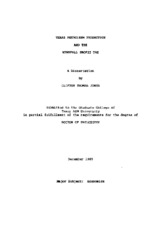| dc.contributor.advisor | Griffin, James M. | |
| dc.creator | Jones, Clifton Thomas | |
| dc.date.accessioned | 2020-08-21T21:40:59Z | |
| dc.date.available | 2020-08-21T21:40:59Z | |
| dc.date.issued | 1985 | |
| dc.identifier.uri | https://hdl.handle.net/1969.1/DISSERTATIONS-420073 | |
| dc.description | Typescript (photocopy). | en |
| dc.description.abstract | This dissertation considers the impact of the federal windfall profit tax (WPT) on aggregate Texas petroleum production. First, an engineering-based economic model is developed that incorporates both the geophysical aspects and economic and policy determinants of competitive petroleum production while allowing for the augmentation of the petroleum reserve base by new infill drilling, the abandonment and re-opening of individual wells extracting from that reserve base, and the effects of production prorationing by state regulatory agencies. The resulting generalized petroleum production model is then econometrically estimated using data from individual oil and gas reservoirs in Texas. After finding that the generalized model performs adequately at the microeconomic level of the individual petroleum reservoir, it is next successfully applied to an analysis of aggregate Texas petroleum production. A simulation model of future aggregate Texas petroleum production from all sources is completed by including an econometric model of future oil production attributable to enhanced oil recovery (EOR) methods. This production model is then combined with an existing econometric model of petroleum drilling in Texas to fashion an integrated simulation model of aggregate petroleum production from a growing reserve base that is constantly being augmented by new reserve additions coming from drilling activity. The integrated model is used to simulate future aggregate Texas production levels from 1984 through 2003 under three alternative WPT phaseout scenarios - repeal of the WPT on 1-1-84, phaseout according to current law, and no phaseout whatsoever. The production differences and welfare effects that would result from changing the status quo phaseout schedule of the WPT to either of the two extremes of immediate repeal or indefinite extension are then determined. General conclusions and policy recommendations regarding the WPT complete the analysis. | en |
| dc.format.extent | xii, 280 leaves | en |
| dc.format.medium | electronic | en |
| dc.format.mimetype | application/pdf | |
| dc.language.iso | eng | |
| dc.rights | This thesis was part of a retrospective digitization project authorized by the Texas A&M University Libraries. Copyright remains vested with the author(s). It is the user's responsibility to secure permission from the copyright holder(s) for re-use of the work beyond the provision of Fair Use. | en |
| dc.rights.uri | http://rightsstatements.org/vocab/InC/1.0/ | |
| dc.subject | Erdölförderung | en |
| dc.subject | Gewinn | en |
| dc.subject | Unternehmensbesteuerung | en |
| dc.subject | Windfall Profit | en |
| dc.subject | Texas | en |
| dc.subject | Petroleum | en |
| dc.subject | Taxation | en |
| dc.subject | Major economics | en |
| dc.subject.classification | 1985 Dissertation J76 | |
| dc.subject.lcsh | Petroleum | en |
| dc.subject.lcsh | Taxation | en |
| dc.subject.lcsh | Texas | en |
| dc.title | Texas petroleum production and the windfall profit tax | en |
| dc.type | Thesis | en |
| thesis.degree.grantor | Texas A&M University | en |
| thesis.degree.name | Doctor of Philosophy | en |
| thesis.degree.name | Ph. D | en |
| dc.contributor.committeeMember | Battalio, Raymond C. | |
| dc.contributor.committeeMember | Hocking, Ronald R. | |
| dc.contributor.committeeMember | Moroney, John R. | |
| dc.type.genre | dissertations | en |
| dc.type.material | text | en |
| dc.format.digitalOrigin | reformatted digital | en |
| dc.publisher.digital | Texas A&M University. Libraries | |
| dc.identifier.oclc | 13911664 | |


